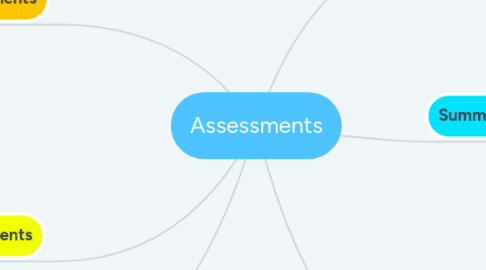
1. Interim/Benchmark Assessments
1.1. Definition: interim/benchmarks are given throughout the entire school year. Interim/benchmarks are used to evaluate where students are at in their learning and how they are progressing.
1.1.1. Example 1: Writing prompts- writing prompts can be given twice a year to see the development that is being made throughout the year of the student.
1.1.2. Example 2: Quarterly Assessments- also known as benchmarks are given at mid-terms.
2. Performance Assessments
2.1. Definition: performance assessments measure the students ability to apply the skills and knowledge they learned from the lesson/unit that has been taught.
2.1.1. Example 1: Playing a game- is a performance task because the student is being asked to follow directions and complete a task given, by performing.
2.1.2. Example 2: Drawing a picture- is an example of performance task because the student is being asked to use their prior knowledge in order to complete a task.
3. Diagnostic Assessments
3.1. Definition: diagnostic assessments are where teachers are able to determines the students strengths, weaknesses and knowledge before instruction.
3.1.1. Example 1: Running Records- the student is being assessed by the teacher based on their reading level.
3.1.2. Example 2: Phonics inventory- the teacher is assessing the student again by their reading efficiency, accuracy, etc.
4. Formative Assessments
4.1. Definition: formative assessments help improve instruction and provide each student with feedback. Formative assessments are used throughout the lesson/unit. These types of assessments are also used to help students know what they need to improve.
4.1.1. Example 1: Exit tickets- are typically where students list 2-3 things they learned in class that day and elaborate on it.
4.1.2. Example 2: In-class Discussions- any conversations whether they are whole group or small group are considered formative assessments.
5. Summative Assessments
5.1. Definition: summative assessments measure the students competency. Summative assessments are always given at the END of each Unit. The teacher is able to see where the student needs growth and if they are able to move onto the next grade.
5.1.1. Example 1: State Assessments- tests given by the state to determine whether a student can move onto the next grade or not.
5.1.2. Example 2: Final Projects- any type of projects at the end of the semester are considered summative assessments. These could be things such as science fair projects.
6. HOT Questions:
6.1. Opening Questions:
6.1.1. Q1: What do you recall about the story we read last week?
6.1.2. Q2: Tell me what you observed from the Title page.
6.2. Guiding Questions:
6.2.1. Q1: Where did the caterpillar lay his egg?
6.2.2. Q2: How many pears did the caterpillar eat through on Tuesday?
6.3. Closing Questions:
6.3.1. Q1: What happened when the caterpillar pushed his way out of his cocoon?
6.3.2. Q2: What does this book remind you of?
